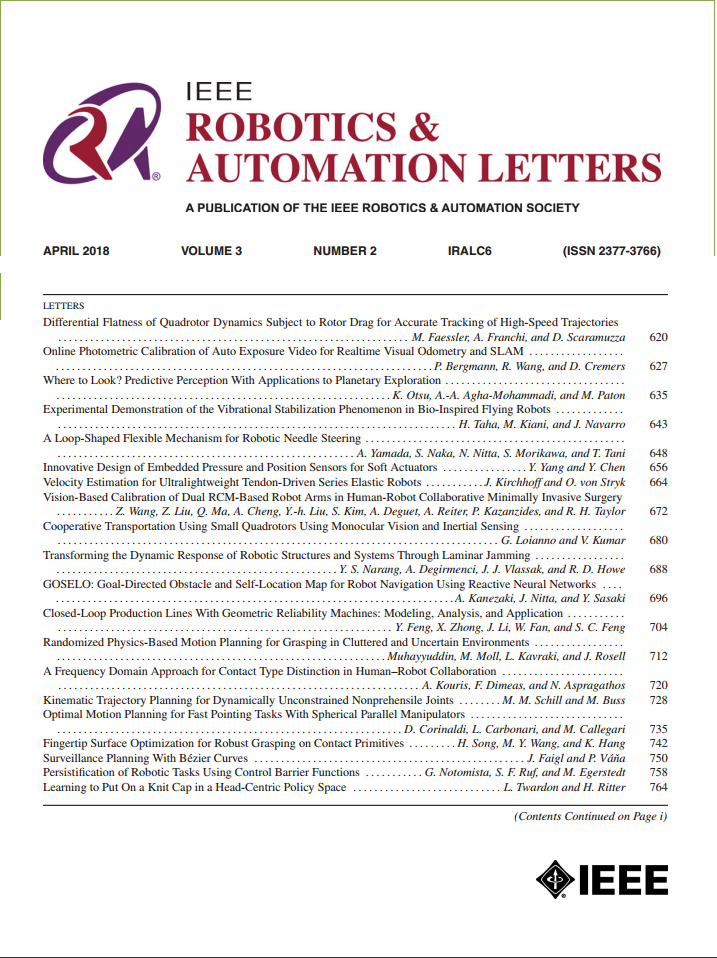CaRoSaC:通过仿真解决线缆下垂问题,实现基于强化学习的线缆驱动并联机器人运动学控制
IF 4.6
2区 计算机科学
Q2 ROBOTICS
引用次数: 0
摘要
这封信介绍了电缆机器人仿真和控制(CaRoSaC)框架,该框架将现实仿真环境与悬索驱动并联机器人(cdpr)的无模型强化学习控制方法集成在一起,考虑了电缆下垂的影响。我们的方法旨在通过建立一个模拟平台来捕捉CDPRs的真实行为,包括电缆下垂的影响,从而弥合由于电缆下垂和精度控制要求等方面在现有研究中缺失且在传统模型中经常被忽视的CDPRs复杂性的知识差距。该框架为研究人员和开发人员提供了一种工具,可以在模拟中进一步开发评估和控制策略,以了解和预测性能的细微差别,特别是在电缆垂度可能很大的复杂作业中。使用这个仿真框架,我们训练了一个基于强化学习(RL)的无模型控制策略。选择这种方法是因为它能够自适应地从cdpr的复杂动态中学习。该策略经过训练以识别最佳电缆控制输入,确保精确的末端执行器定位。与传统的基于反馈的控制方法不同,我们的RL控制策略侧重于运动控制,并解决了电缆下垂问题,而不依赖于预定义的数学模型。我们还证明,我们基于rl的控制器,加上柔性电缆仿真,明显优于经典的运动学方法,特别是在动态条件下和靠近工作空间的边界区域。正如我们的实验所证明的那样,所描述的仿真和控制方法的综合强度为操纵悬浮cdpr提供了有效的解决方案,即使在传统方法失败的工作空间边界条件下,也可以确保cdpr在各种应用中发挥最佳功能,同时考虑到经常被忽视但关键的电缆垂度因素。本文章由计算机程序翻译,如有差异,请以英文原文为准。
CaRoSaC: A Reinforcement Learning-Based Kinematic Control of Cable-Driven Parallel Robots by Addressing Cable Sag Through Simulation
This letter introduces the Cable Robot Simulation and Control (CaRoSaC) Framework, which integratesa realistic simulation environment with a model-free reinforcement learning control methodology for suspended Cable-Driven Parallel Robots (CDPRs), accounting for the effects of cable sag. Our approach seeks to bridge the knowledge gap of the intricacies of CDPRs due to aspects such as cable sag and precision control necessities, which are missing in existing research and often overlooked in traditional models, by establishing a simulation platform that captures the real-world behaviors of CDPRs, including the impacts of cable sag. The framework offers researchers and developers a tool to further develop estimation and control strategies within the simulation for understanding and predicting the performance nuances, especially in complex operations where cable sag can be significant. Using this simulation framework, we train a model-free control policy rooted in Reinforcement Learning (RL). This approach is chosen for its capability to adaptively learn from the complex dynamics of CDPRs. The policy is trained to discern optimal cable control inputs, ensuring precise end-effector positioning. Unlike traditional feedback-based control methods, our RL control policy focuses on kinematic control and addresses the cable sag issues without being tethered to predefined mathematical models. We also demonstrate that our RL-based controller, coupled with the flexible cable simulation, significantly outperforms the classical kinematics approach, particularly in dynamic conditions and near the boundary regions of the workspace. The combined strength of the described simulation and control approach offers an effective solution in manipulating suspended CDPRs even at workspace boundary conditions where traditional approach fails, as proven from our experiments, ensuring that CDPRs function optimally in various applications while accounting for the often neglected but critical factor of cable sag.
求助全文
通过发布文献求助,成功后即可免费获取论文全文。
去求助
来源期刊

IEEE Robotics and Automation Letters
Computer Science-Computer Science Applications
CiteScore
9.60
自引率
15.40%
发文量
1428
期刊介绍:
The scope of this journal is to publish peer-reviewed articles that provide a timely and concise account of innovative research ideas and application results, reporting significant theoretical findings and application case studies in areas of robotics and automation.
 求助内容:
求助内容: 应助结果提醒方式:
应助结果提醒方式:


